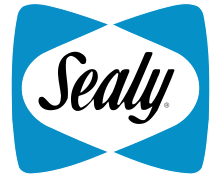Sealy Corporation
 |
|
| Subsidiary | |
| Industry | Furnishings |
| Founded | Sealy, Texas (1881) |
| Founder | Daniel Haynes |
| Headquarters | Trinity, North Carolina, U.S. |
|
Key people
|
Larry Rogers, President and Chief Executive Officer |
| Products | Bedding |
|
Number of employees
|
4,817 (full-time) |
| Parent |
Tempur Sealy International (2012–present) |
| Website | www.sealy.com |
Sealy (formerly the Sealy Corporation) is a brand of mattresses marketed and sold by Tempur Sealy International. Sealy draws its name from the city where the Sealy Corporation originally started, Sealy, Texas.
In 1881, cotton gin builder Daniel Haynes lived in Sealy, Texas, located west of Houston. Haynes began making cotton-filled mattresses for his friends and neighbors. In 1889, he patented an invention that compressed cotton for use in his mattresses. Eventually the mattresses became so popular he was able to sell the patents to manufacturers in other markets. The term "Mattress from Sealy" was coined to describe what was produced.
During 1906, after much success as an advertising executive, Earl Edwards purchased the patents and gained manufacturing knowledge from Haynes. Edwards took the name "Sealy" for his new company and expanded it to a national market.
Due to lack of funding for manufacturing, Sealy expanded using a licensing-expansion similar to Coca-Cola. By 1920, Sealy had 28 licensed plants and became the first mattress company to expand using a licensing program.
During the Great Depression the mattress industry was hit hard. Sealy lost most of its licensees and narrowly escaped bankruptcy itself. During this time Sealy consolidated with the surviving licensees and created what is now known as Sealy, Incorporated.
Sealy operated as a franchisor out of its Chicago headquarters and its licensees were, under the terms of their licensing agreement, only supposed to sell in a designated trading area that did not conflict with other franchisees. The largest licensee, Cleveland-based Ohio Mattress Company (founded by the Wuliger family and still operated by Ernest M. Wuliger), defied these restrictions and sold into markets reserved for other franchisees. The conflict resulted in Ohio Mattress filing an antitrust suit against Sealy in 1971. The issue was decided fifteen years later with a near-total victory for Ohio Mattress. Unable to come up with the $77m award, Sealy Incorporated and all but one of the other franchisees were forced to sell to Ohio Mattress, and the company became the world's largest bedding manufacturer by sales.
Merchant banking firm Gibbons Green Van Amerongen took Sealy private in an April 1989 leveraged buyout, a deal which netted Sealy shareholders US$965m. First Boston made a bridge loan to the buy-out firm just as Drexel Burnham Lambert was running into trouble and the junk bond market was drying up, and was stuck with the loan. The failed deal, known as "burning bed," led to a dramatic slow-down in leveraged buy-outs. Gibbons Green dissolved and First Boston was forced into the arms of Credit Suisse.
...
Wikipedia
